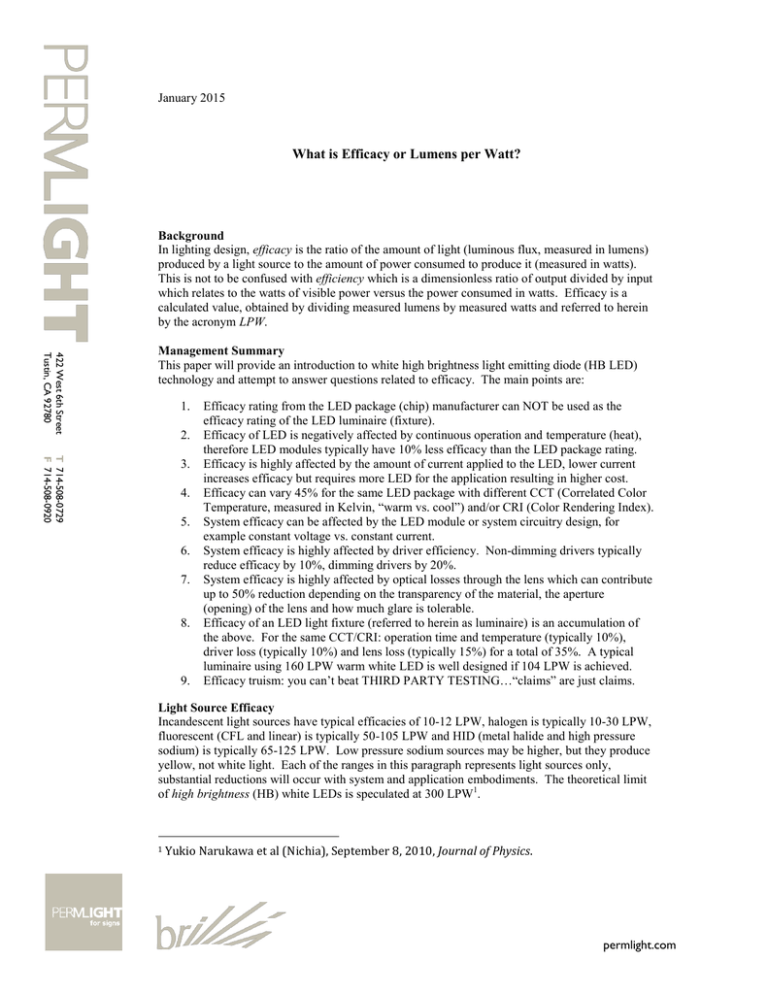What is Efficacy or Lumens per Watt?
advertisement

January 2015 What is Efficacy or Lumens per Watt? Background In lighting design, efficacy is the ratio of the amount of light (luminous flux, measured in lumens) produced by a light source to the amount of power consumed to produce it (measured in watts). This is not to be confused with efficiency which is a dimensionless ratio of output divided by input which relates to the watts of visible power versus the power consumed in watts. Efficacy is a calculated value, obtained by dividing measured lumens by measured watts and referred to herein by the acronym LPW. 422 West 6th Street Tustin, CA 92780 Management Summary This paper will provide an introduction to white high brightness light emitting diode (HB LED) technology and attempt to answer questions related to efficacy. The main points are: 1. 2. T 714-508-0729 F 714-508-0920 3. 4. 5. 6. 7. 8. 9. Efficacy rating from the LED package (chip) manufacturer can NOT be used as the efficacy rating of the LED luminaire (fixture). Efficacy of LED is negatively affected by continuous operation and temperature (heat), therefore LED modules typically have 10% less efficacy than the LED package rating. Efficacy is highly affected by the amount of current applied to the LED, lower current increases efficacy but requires more LED for the application resulting in higher cost. Efficacy can vary 45% for the same LED package with different CCT (Correlated Color Temperature, measured in Kelvin, “warm vs. cool”) and/or CRI (Color Rendering Index). System efficacy can be affected by the LED module or system circuitry design, for example constant voltage vs. constant current. System efficacy is highly affected by driver efficiency. Non-dimming drivers typically reduce efficacy by 10%, dimming drivers by 20%. System efficacy is highly affected by optical losses through the lens which can contribute up to 50% reduction depending on the transparency of the material, the aperture (opening) of the lens and how much glare is tolerable. Efficacy of an LED light fixture (referred to herein as luminaire) is an accumulation of the above. For the same CCT/CRI: operation time and temperature (typically 10%), driver loss (typically 10%) and lens loss (typically 15%) for a total of 35%. A typical luminaire using 160 LPW warm white LED is well designed if 104 LPW is achieved. Efficacy truism: you can’t beat THIRD PARTY TESTING…“claims” are just claims. Light Source Efficacy Incandescent light sources have typical efficacies of 10-12 LPW, halogen is typically 10-30 LPW, fluorescent (CFL and linear) is typically 50-105 LPW and HID (metal halide and high pressure sodium) is typically 65-125 LPW. Low pressure sodium sources may be higher, but they produce yellow, not white light. Each of the ranges in this paragraph represents light sources only, substantial reductions will occur with system and application embodiments. The theoretical limit of high brightness (HB) white LEDs is speculated at 300 LPW1. 1 Yukio Narukawa et al (Nichia), September 8, 2010, Journal of Physics. permlight.com 3mm LED package As of January 2015, LED (light emitting diode) packages (sometimes erroneously called chips) have been created in laboratory environments reaching efficacies of 240 lumens per watt. However, in mass production as of January 2015, high quality HB LED SMD (surface mount device) packages are available up to 181 LPW for cool white (more explanation to follow) and 158 LPW for warm white.2 The term chip technically refers to the semiconductor die which is about the size of a single piece of course ground black pepper. The die is assembled into a SMD package which typically ranges in size from 3mm to 10mm (0.12” to 0.40”). The LED package is typically soldered onto a printed circuit board (PCB) to create an LED module. Most often metal core printed circuit boards (MCPCB) are used to more effectively couple the heat transfer out of the LED die3. The importance of this will be discussed later. LED module with MCPCB and 3mm LED packages 422 West 6th Street Tustin, CA 92780 Manufacturers of LED luminaires or LED modules must NOT assume the same efficacy values as the LED package manufacturer specifies. There are several factors that influence efficacy including but not limited to: operating temperature and time, operating current, LED correlated color temperature (CCT) and/or color rendering index (CRI), circuit efficiency, driver (power supply) efficiency and optics efficiency. T 714-508-0729 F 714-508-0920 Operating Temperature and Time As opposed to most conventional light sources, HEAT is the enemy of LED. When continuous current is applied to an LED, it gets hot. The LED package is tested by high speed robotic equipment at room ambient temperature (Ta) of 25°C in a pulsed current mode at typically 10 milliseconds (ten thousandths of a second). Unfortunately, this test prevents the LED from continuous heating as it would in the end luminaire application, but the measurement technique is understood by and useful to experts in semiconductor manufacturing. The LPW rating published from this test method is definitely NOT relevant to the real world scenario in a luminaire where the LED package will run in continuous mode (DC operation) and at higher temperature due to current generated heating and most likely higher (surrounding) temperature ambient air (Ta). Most LED can be operated safely up to a junction temperature (Tj) of 120°C. Tj is a calculated temperature of the semiconductor die inside the LED package. The actual thermal measurement is made on the PCB next to the LED package, referred to as Solder-pad Temperature (Ts). Industry standards such as LM-80 typically limit Ts to 105°C. The efficacy of a white HB LED typically decreases at about 0.266 percent per °C4. For example, a warm white LED rated at 158 LPW (pulsed mode at Ta = 25°C) running in continuous mode at Tj = 80°C (very typical application) rises approximately 55°C x 0.266% reduction = 15% less lumens which translates to 134 LPW. Several LED packages located into a smaller proximity create more heat and reduce efficacy. Therefore, when designing an LED module, it is best from a thermal consideration (and long-term life) to spread the LED packages further away from each other. Unfortunately this increases module size and cost. Nichia Reference literature. Permlight, US Patent 6,712,486 - Mounting Arrangement for Light Emitting Diodes. 4 Typical Nichia HB SMD LED specification, ambient temperature vs. relative luminous flux. 2 3 permlight.com Similarly, LED packages utilizing more than a few series/parallel semiconductor chips in close proximity inside the package typically have lower efficacy and higher cost than LED packages with fewer number of chips. This is because the heat generated in the chips cannot be properly evacuated from the LED package. The external ambient temperature (Ta) of an LED system will affect efficacy. Typically, the efficacy of a system will parallel the above LED package formula. For example, the efficacy of a luminaire operating in Phoenix, Arizona during daylight summer hours may have 15% less efficacy than the same luminaire operating at room temperature. For practical application, the efficacy of an LED package should be “de-rated” (decreased in value) by at least 10% from the package manufacturer’s specification when mounted onto an LED module that will be operated continuously in a luminaire (just about every lighting application). 422 West 6th Street Tustin, CA 92780 Operating Current The operating current of an LED package directly impacts efficacy. For example, an LED designed to be operated at 350mA current will typically have a higher efficacy value at 100mA. The main reason the efficacy is higher is because the heat is being reduced as described previously. Typically, operation at a lower current than the LED package manufacturer’s recommended specification (referred to as under driven) will increase the efficacy. Similarly, to improve efficacy while achieving a given illuminance for a task, one may choose to use more LED packages (referred to as high density array) at reduced operating current which in effect is under driving. Permlight successfully demonstrated this high density array approach in 2010 with several LED modules, other manufacturers have recently begun to emulate this technique. T 714-508-0729 F 714-508-0920 The detriment to utilizing an LED package at less than its rated current or using more LED packages than are required for the task is its adverse effect on cost. Lower currents may also potentially require a non-standard driver which can increase cost or reduce speed to market. As of January 2015, LED cost reduction is a critical industry concern if LED adoption as a general lighting source is to be accelerated further. LED CCT and CRI Fluorescent light sources since the 1980’s have been able to produce similar light output over their CCT range of warm white to cool white (typically 2700K to 6500K) and small light output variances from lower to higher CRI (typically 70-85). However, LED light sources have a significant variance in light output with different CCT and CRI. The American National Standards Institute (ANSI) has established standard range bins for CCT. The graph on the right defines some of the LED white ANSI bins5. 5 Courtesy of Cree, XLamp XP Family LEDs, CLD-AP22 REV 13 permlight.com The chart on the right shows the effect on Relative Luminous Intensity (light output) for LED packages at various CCT and CRI6. The intensity value is shown decreasing from 100% for 5000K/70CRI to 55% for 2700K/90CRI. Decreased intensity value directly translates to decreased efficacy. 70CRI 80CRI 90CRI For example, today’s high performance HB LED package with CCT of 5000K and 70 CRI is rated 170 LPW, whereas the same package with CCT of 2700K and 90 CRI is rated about 110LPW. This represents a 35% decrease in efficacy! As a general rule of thumb, reducing the CCT by one ANSI bin typically reduces the intensity (therefore efficacy) by about 6%. Maintaining same CCT but increasing CRI from 70 to 80 will typically reduce efficacy by 6%. Increasing CRI from 80 to 90 typically reduces efficacy by 20%. 422 West 6th Street Tustin, CA 92780 Therefore it is meaningless to specify an LED luminaire’s efficacy rating without defining both the CCT and CRI. Furthermore, it is generally not possible to obtain the same efficacy across the full CCT and CRI range for white LEDs. T 714-508-0729 F 714-508-0920 Circuit Efficiency The efficiency of the circuit is another factor influencing the efficacy of the LED System. As mentioned previously, the efficacy rating of an LED package is reduced by about 10% when assembled onto a module and run at a continuous current. There are several methods of connecting LEDs together on the MCPCB to create the circuit. To produce light, LEDs require forward current and exhibit a typical Vf (forward voltage) of 3V at their rated current. LED drivers (power supplies) with 3V output rating are not very common, therefore the LED are typically connected in series and/or parallel to match an off-the-shelf voltage or current rating of an LED driver. A constant current circuit requires a driver with DC current output matched to the rated current of the LED. For example, a 350mA LED can be directly driven by a 350mA LED driver. Using a lower current driver will reduce light output, using a higher current driver will over-heat the LED and reduce lifetime. Since LED modules and luminaires are rarely comprised of just one LED, multiple LED packages are arranged in a series string. For example, a string of 10 LED in series would require a 30VDC (10 LED x 3V each), 350mA DC driver, which is fairly standard in the industry. One concern with this arrangement is that if one LED fails, the entire series string of LEDs will not illuminate. Recall the old-style Christmas tree light bulb strings that were in series, when one fails, they all go out. That’s why newer Christmas light strings are in parallel. It is possible to parallel LED with a constant current circuit (meaning to share the driver output current), but additional electronic components (which add cost) must be used to balance the current evenly between parallel circuits; otherwise lifetime will be reduced in the circuit that experiences higher current. Constant current circuitry is typically very efficient (thereby high efficacy), but there are other limitations such as: no flexibility on drive current (which highly affects efficacy, defined in next section) and high DC voltages on the module which are not safe for consumers to touch. 6 2009 Nichia Corporation Business Planning Department Technical Support Group permlight.com A constant current circuit module therefore will typically have low circuit losses, but the LED module efficacy rating will remain less than the LED package rating, affected proportionally, as discussed above, by CCT, CRI, number of LEDs used (heat load) and percentage of rated current applied. A typically impact will be 10% less efficacy. A constant voltage circuit requires a driver with voltage output above the Vf of the LED. A 3V driver is not off-the-shelf, but 12VDC (for example) is very popular. Therefore LEDs are typically arranged in series strings (3 LEDs x 3V = 9V). The extra 3V (energy) is dissipated by electronic components such as resistors or current regulators. This can lose up to 25% in efficiency (translates equally to efficacy); however there are several advantages to the constant voltage configuration. Arguably the most important is that the 3-LED strings can be connected in parallel up to the maximum output current of the constant voltage power supply. For example, 10 parallel strings of 350mA LEDs require 3.5A, whereas 5ADC, 12VDC (60WDC) constant voltage drivers are off-the-shelf. In this example, if one LED fails, you lose only that 3-LED string, the other 9 strings continue to operate. A constant voltage circuit module will typically have about 13% less efficacy than a constant current module. However, the benefits are: 422 West 6th Street Tustin, CA 92780 Multiple modules can be connected to single off-the-shelf driver up to maximum wattage The voltage of the system remains low which is safer to consumers The parallel configuration provides redundancy to reduce the chance of system failure. T 714-508-0729 F 714-508-0920 Driver Efficiency The efficiency of the LED driver directly impacts the efficacy of an LED system or luminaire. The efficacy of an LED light engine (LED driver plus LED module) is always lower than the efficacy rating of the LED module. The efficacy of an LED module is rated by its DC input power, whereas a light engine is rated by its AC input power consumption which includes the driver’s efficiency losses. In general, higher power (wattage) LED drivers are more efficient than lower power drivers. The efficiency varies slightly depending on the load (amount of LED connected) and input voltage (higher AC input voltage yields higher efficiency). As of January 2015, constant current drivers in the range of 50-150W are typically 90% efficient, 6-40W drivers are typically 85% efficient. Constant voltage LED drivers in similar wattage range are typically 83% efficient. LED drivers which are dimmable (depending on power rating and dimming technology) are typically 80% efficient for low power and 90% for high power. As a general rule of thumb, the efficacy of an LED light engine will be 10 to 20% less than the efficacy of the LED module. Optical Efficiency The optics (reflector or lens) of an LED luminaire has the potential for the greatest impact on system efficacy. A clear glass lens may have a loss of 8%. Diffusing lenses (such as prismatic or frosted) may have up to 50% efficacy loss. A basic tenet of luminaire design is that the clearer the lens, the greater the glare. Luminaires where the individual LED light sources can be seen are typically considered high glare and consequently are not welcomed by users. Conclusions and Recommendations This paper addresses the fact that system efficacy (LPW) is not a one-dimensional or simple subject. There are many factors that can negatively influence the efficacy of the LED operation and the efficiency of a luminaire and therefore the LED system efficacy. The efficacy measurement is a good gauge of a well-designed LED system which will adequately illuminate its task with a minimum waste of energy. It is important that all the factors reviewed herein are incorporated when evaluating efficacy claims and that third party testing (a neutral source such as a DOE certified test laboratory) is utilized to place competing claims on an equal basis. permlight.com



![Quality assurance in diagnostic radiology [Article in German] Hodler](http://s3.studylib.net/store/data/005827956_1-c129ff60612d01b6464fc1bb8f2734f1-300x300.png)